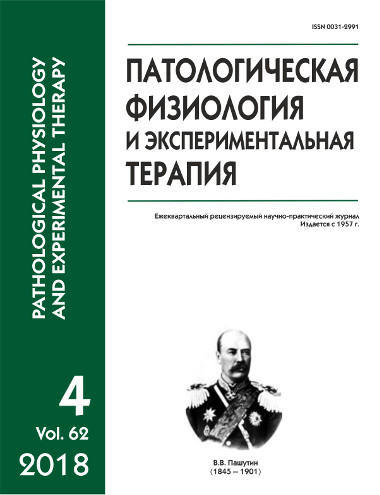Cerebro-hepatic protecttive activity of complex compound of succinic acid with 1.3.6-trimethyl-5-hydroxyuracil in experimental intoxication by sodium nitrate
Abstract
The aim of the work was to study the cerebro-hepatoprotective effect of the complex compound of succinic acid with 1,3,6-trimethyl-5-hydroxyuracil (CC) in acute nitrite intoxication in comparison with mexidol. Methods. The experiments were carried out on male rats weighing 180—240 g. Acute intoxication was caused in rats by subcutaneous injections of 90 mg/kg of sodium nitrite. Hemoglobin and erythrocytes were studied in the blood of animals, determined the total level of adenosine triphosphate (ATP), the activity of superoxide dismutase (SOD), catalase, glucose-6-phosphate dehydrogenase (g-6-PDG), and the number of diene conjugates (DC). The markers of the metabolic state of hepatocytes were: the activity of urokininase (UrK), alanine and aspartate aminotransferase (AlAT, AsAT) and alkaline phosphatase (AP), the content of diene conjugates (DC) and Schiff bases (SB). In the brain, the activity of succinate dehydrogenase (SDG) and monoamine oxidase (MAO), as well as the content of DC and SB was investigated. Antioxidant was injected in a dose of 5 mg/100 g of body weight daily with an interval of 12 hours for 5 days, starting from the moment of introduction of the toxicant, testing is carried out on the 5-7th day. Results. It has been established, that the introduction of sodium nitrite suppresses the activity of enzymes of antioxidant protection — the level of catalase and SOD, reduces the level of ATP and significantly increases the amount of DC in erythrocytes. In the blood of poisoned rats, an increased activity of UrK, AlAT, AsAT and alkaline phosphatase is detected, the content of DK and SHO increases in the liver tissue in the background of a decrease in catalase activity. In the brain in poisoned rats, the activity of MAO, LDH and catalase decreases, the number of DCs increases. It has been established, that CC, like mexidol, under conditions of acute intoxication, simulated by sodium nitrite, have a cerebro and hepatoprotective effect, positively, but in different degrees, affect the redox energy state of erythrocytes. The cerebroprotective effect of CC is achieved by stabilizing cerebral monoamine oxidase (MAO), succinate dehydrogenase (SDG), lipid peroxidation (LP) and antioxidant protection of enzyme activity. Conclusions. The results show that the protective activity of the COP is higher in comparsion with the Mexidol. The membrane stabilizing and antioxidant effect plays an important role in the mechanism of the protector effect of the CC.






